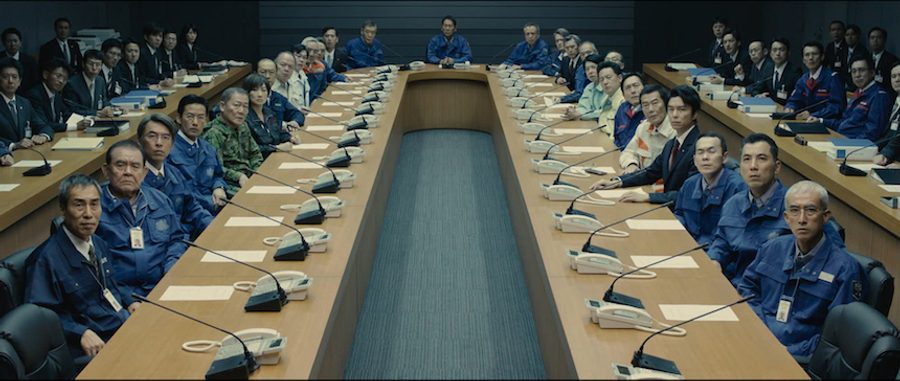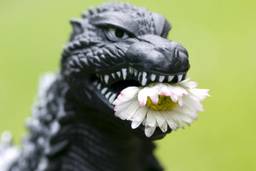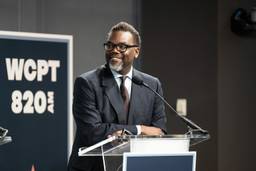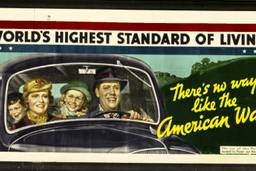A New Godzilla for a New, Nationalistic Japan
“Shin Godzilla” sheds the monster’s pacifist origins and shows a Japan eager to get out from under Washington’s thumb.
Steve Ryfle

Midway through Shin Godzilla, American B2 stealth bombers drop their payload on the monster as it tramples through Tokyo. The creature launches a massive counterattack, tantamount to a nuclear explosion, and through the CGI fire and smoke the implication becomes clear: Japan can no longer rely on the United States to keep it safe.
At a time when Japan faces existential threats from China and North Korea, and when some of its leaders question America’s commitment to defend its longtime ally or suggest it’s time all American bases and troops leave the country, the 29th Godzilla feature from Toho Studios imagines a world in which Japan gets out from under Washington’s thumb. With a paean to the country’s Self Defense Forces and espousing themes of national and cultural pride, the film shows Japan flexing a bit of its own military muscle and breaking rank with the U.S. to save itself from destruction through a homegrown combo of political, diplomatic and scientific means.
Shin Godzilla (“New Godzilla”), which has a limited U.S. theatrical engagement from October 11 to 18, is being marketed here as a typical city-smashing affair. But if Godzilla movies are the definition of formulaic, this one is certainly unconventional. It’s not truly a monster or disaster movie at all, but a faux-documentary look at politicians and bureaucrats responding to a doomsday scenario, with all of the deadlocked meetings, endless discussions, conference calls and staring at computer screens. If it sounds impersonal, it is — nobody in the film is outside the governmental bubble, and nobody has much of an individual story. What the film eschews in personal emotion, however, it replaces with a sense of national pride, embodied not by the bumbling, indecisive, pass-the-buck, old-school politicians (in a fine moment of satire, the aging prime minister is more concerned about a bowl of soggy noodles than the situation at hand) but by the younger, patriotic and clear-headed generation that leads the country out of the mess.
Within this core of “soft nationalism” lies a tacit endorsement of the policies of Japan’s current conservative leader, Prime Minister Shinzo Abe, who has made it known he wants to revise Japan’s U.S.-drafted constitution, which General Douglas MacArthur forced upon the country in 1947. Japan’s armed forces were disbanded after World War II; under constitutional guidelines, the Self Defense Forces were established in 1954 but limited to defending the country against internal threats and responding to natural disasters, and prohibited from offensive operations on behalf of Japan or its allies. Japan’s national defense is proscribed by the 1951 U.S.-Japan Mutual Security Treaty, under which Washington still maintains 54,000 troops there, though the American military presence is a longstanding source of tension between the two nations. Abe believes Japan would be better served with a traditional, autonomous military.
Rumored to have cost only $10 million, Shin Godzilla has been a major hit in Japan, well surpassing the $160-million Hollywood remake of 2014. Japanese fans reportedly enjoyed the film’s patriotic spirit, rat-tat-tat dialogue and depictions of bureaucratic bungling. Abe himself has credited its success to its conservative politics: “I think that [Godzilla’s] popularity is rooted in the unwavering support that the public has for the Self-Defense Forces,” he recently said, according to the Washington Post.
It’s been 12 years since a new Japanese-made Godzilla movie, and it was during that time that Abe rose to become arguably the nation’s most consequential, if oft-controversial, prime minister since World War II. Abe has pushed to strengthen the Self-Defense Forces’ air and naval capabilities, and won passage of a plan permitting the SDF to engage in overseas combat for the first time since World War II. This dramatic shift in military posture is supported by Washington because it enables Japan to send troops or vessels to help Americans in combat operations, but it drew big crowds of antiwar protesters in Tokyo.
Shin Godzilla, however, meditates upon Abe’s most controversial idea: to revise the constitution’s Article 9, which declares that “the Japanese people forever renounce war as a sovereign right of the nation and the threat or use of force as means of settling international disputes.” Given China’s ongoing military buildup in the South China Sea and other threats, Abe has said the restrictions on Japan’s military “do not fit into the current period.” Detractors worry Japan could eventually transform from a peaceful U.S. wingman into a major remilitarized world power. This friction between a pacifist stance and the need for military self-determination has persisted ever since Tokyo and Washington first forged postwar ties. Abe’s grandfather Nobusuke Kishi, who was prime minister in the late 1950s, similarly wanted to abolish Article 9 , but could not muster popular support. Instead, Kishi got the Eisenhower Administration to revise the Mutual Security Treaty and strengthen Washington’s pledge to defend Japan. Opponents feared the arrangement would pull Japan into a U.S. war with the Soviets, and after massive demonstrations, Kishi resigned.
Today, Japanese domestic politics is back-page stuff in mainstream U.S. newspapers; thus some American viewers more accustomed to watching Godzilla fight Mothra or Mechagodzilla may be perplexed as this film instead painstakingly shows bureaucrats and cabinet ministers struggling to find constitutional justification for the use of military force (something nobody ever worried about in the old Godzilla movies). Generals and soldiers assume an easy victory against the outsized creature advancing on Tokyo, but the nominal hero, young Deputy Chief Cabinet Secretary Rando Yaguchi (Hiroki Hasegawa), knows the errors of the past: “Wishful thinking and armchair theories by the old Imperial Army in the last war led to 3 million Japanese lives lost. Beware of unfounded optimism.” This being a Godzilla film, Yaguchi is of course proven right, and the monster withstands assaults by both Japanese and U.S. forces — though it’s the latter’s massive firepower that triggers Godzilla’s retaliation and ensuing carnage.
Shin Godzilla portrays the U.S. in a less than flattering light, as an overbearing giant willing — as some real-life Japanese leaders have worried — to sacrifice Japan to protect its own interests. After expending its energy against the stealth bombers, Godzilla goes into hibernation. Fearing the creature will awaken and eventually reach U.S. shores, Washington and a coalition of United Nations sycophants force the Japanese government to evacuate Tokyo for a nuclear strike on the sleeping monster. One young official concedes that his hapless country is merely America’s “tributary state.”
America is personified, none too subtly, in Kayoko Ann Patterson (Satomi Ishihara), a 20-something Japanese-American presidential envoy. She’s pushy, flirty, has no time for Japanese “honorifics” and shops at Zara during a national emergency. Ultimately, her Japanese roots trump all, however, and Patterson assists the Japanese government in undercutting Washington’s conclusion that “our nuclear wisdom is the only road to salvation for mankind,” as one scientist awkwardly puts it. The third act is a standard race against the clock to deliver a freezing coagulant into Godzilla’s bloodstream and neutralize the kaiju before the missile is launched.
Things have changed since Ishiro Honda’s Godzilla (1954), made just two years after the occupation ended, and at a time when Japan depended wholly on the U.S. for its economic and military security. Honda’s film sounded an alarm against nuclear proliferation and graphically revisited the horrors of Hiroshima, Nagasaki and the Tokyo fire raids. The monster was both a manifestation of the bomb and an attempt to reckon with the country’s war making. Honda skewered the cowardice of Japanese politicians unwilling to confront Washington over the H-bomb test that awakened Godzilla (reflecting the political response to the Lucky Dragon nuclear accident that same year) and more concerned about preserving trade routes than public safety. Shin Godzilla is far more overtly political, and in its implicit affirmation of the Abe administration’s worldview and its alter-reality wherein Japan’s young idealists subvert Washington’s deadly directive, it has little use for the original film’s unfettered pacifism.
That said, Godzilla’s metaphor has always changed with the times. It helped satirize the banality of early Japanese television in King Kong vs. Godzilla (1962); it fought Japan’s runaway pollution problem in Godzilla vs. Hedorah (1971); it was a focal point of Reagan-era Cold War tensions in Godzilla (1984); and it was even more plainly nationalistic in Godzilla vs. King Ghidorah (1991), defending Japan against Caucasian time-travelers bent on crashing the country’s bubble economy.
Ignoring the 1954 original and all its idiosyncratic sequels, the 2016 film conceives of Godzilla not as a long-dormant dinosaur but a highly evolved mutation of sea organisms exposed to illegally dumped radioactive waste, and capable of rapid propagation that will wipe out mankind. The latest version of the monster — glowing red-hot, leaving a swath of radiation in its wake, creating a wave of floating cars, boats, and structures as it reaches land, and requiring mass evacuations — is unmistakably symbolic of the 2011 tsunami and Fukushima Daiichi nuclear disaster that killed 16,000 and left 160,000 homeless.
The final effort to neutralize Godzilla, with hazmat-suited workers entering the irradiated zone on what’s certainly a suicide mission (“Japan’s future we place in your hands,” the hero Yaguchi says in a rousing, patriotic speech) is successful. The frozen monster remains standing in the middle of Tokyo, a disaster monument not unlike the decaying remains of the Fukushima reactor, a big mass of broken concrete and twisted metal that will remain indefinitely.
But ultimately the Fukushima allegory is secondary; the film quickly pivots back to more soft nationalisms, the expression of Japanese cultural pride encouraged by the government and associated with young citizens. Recalling the aftermath of World War II, Shin Godzilla ends with a decimated Japan and its youngish leaders pledging, with international assistance, to meet the challenge of rebuilding it. Yaguchi bids goodbye to the Japanese-American heroine, scoffing at the idea that his country will forever remain Washington’s puppet.
Generations of Japanese have now grown up with no direct memory of World War II, but they have still inherited the country’s war legacy and its long history of being ravaged by natural disasters. In that sense, the theme of enduring and rebuilding that runs through Shin Godzilla is true to the monster’s original message, even if the film’s right-leaning politics are not.
“It was imprinted on my psyche that Tokyo could be annihilated any minute,” director Hideaki Anno, best known as creator of the internationally popular, apocalyptic Evangelion anime franchise, told the Japan Times in 2014. “I never experienced the horrors of war that my parent’s generation did, but the imagery is very familiar to me, as is the Cold War-era fear of nuclear war. The feeling that it could happen is still with me.”
SPECIAL DEAL: Subscribe to our award-winning print magazine, a publication Bernie Sanders calls "unapologetically on the side of social and economic justice," for just $1 an issue! That means you'll get 10 issues a year for $9.95.





